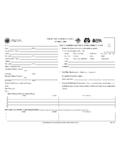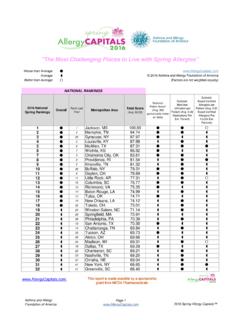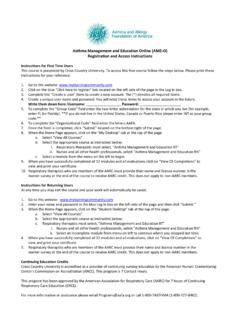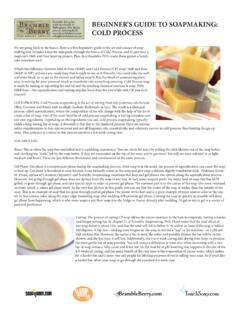Transcription of The Most Challenging Places to Live With Allergies
1 1235 South Clark Street Suite 305 Arlington, VA 22202 800-7-ASTHMA (800-727-8462) Most Challenging Places to Live With Allergies 2020 Asthma and Allergy Foundation of the Quality of Life for People With Seasonal Allergies The Asthma and Allergy Foundation of America (AAFA) is pleased to share the 2020 Allergy Capitals report. This year s report uses both spring and fall allergy data to rank the 100 largest cities in the continental United States. Since 2003, AAFA has produced this report to help people recognize, prevent and manage allergy symptoms. The report also helps communities identify where the needs of people with allergic diseases can be better met. Through the ranking, we seek to raise awareness about the impact of seasonal Allergies and provide helpful information to improve the quality of life for people who experience them. Both spring and fall pollen has increasingly strengthened with longer, warmer growing seasons that produce stronger pollen at higher quantities.
2 While mold can grow any time of year, outdoor mold is worse in the fall, adding to fall allergy concerns. Communities need to work together to provide solutions to the challenges raised by climate change, rising health care costs and access to specialized care. AAFA is dedicated to improving the quality of life for people with asthma and allergic diseases through education, advocacy, research and support. We will continue to promote public policy initiatives that improve and protect quality of life and treatment options for those affected. People with asthma and Allergies should be able to find relief no matter where they live. In this report, we cover: Background ..3 About Seasonal Allergies ..4 Managing Your Contact With Pollen ..5 The Most Challenging Places to Live With Allergies ..6 Seasonal Ranking of Most Challenging Places to Live With Allergies ..10 Methodology, Acknowledgements and References.
3 14 IMPACT OF 2018 HURRICANES ON POLLEN DATATwo major hurricanes hit the in 2018. Hurricane Florence affected the Carolinas, and Hurricane Michael made landfall in Florida. Based on our year-over-year comparison of 2018 to 2019 spring pollen data, we found significant drops in pollen counts in Raleigh, North Carolina, and parts of North and Central Florida. 2020 Asthma and Allergy Foundation of For millions of Americans, Allergies are life-limiting. Allergic conditions are among the most common medical conditions affecting They are of special concern among the People with Allergies need to find what may trigger their Allergies and find ways to reduce exposure and consider appropriate Allergies are a major public health concern. More than 50 million Americans suffer from Allergies every It is among the country s most common, but overlooked, diseases. There is no cure for Allergies .
4 But Allergies can be managed with prevention and treatment. A good allergy treatment plan is based on medical history, the results of allergy tests and symptom severity. It can include three treatment types: Reducing and avoiding allergens Medicine options Immunotherapy (allergy shots or sublingual therapy) One of the most common allergic conditions is allergic rhinitis, often called hay fever. It causes symptoms such as: Sneezing Stuffy nose Runny nose Watery eyes Itching of the nose, eyes or the roof of the mouth Allergic sensitivity to airborne mold spores or pollens from trees, grasses or weeds tends to cause symptoms. Allergic rhinitis occurs in about 18% of children, mostly in Southern and Southeastern Allergic rhinitis can be seasonal or year-round. Symptoms of seasonal allergic rhinitis usually occur in spring, summer and/or early THE ASTHMA AND ALLERGY FOUNDATION OF AMERICAF ounded in 1953, AAFA is the oldest and largest non-profit patient organization dedicated to saving lives and reducing the burden of disease for people with asthma, Allergies and related conditions through research, education, advocacy and support.
5 AAFA empowers patients and their families by providing practical, evidence-based information and community programs and services. AAFA offers extensive online support communities for individuals and families affected by asthma and allergic diseases, such as food Allergies and atopic dermatitis (eczema). AAFA also helps consumers identify products to help them create healthier homes through the asthma & allergy friendly Certification Program. For more information, visit , and 2020 Asthma and Allergy Foundation of Seasonal Allergies People with allergic rhinitis may have symptoms that get worse during one season over another. Why? Different types of allergens peak at different times of the year. In the spring, tree pollen is more common. In the fall, weed pollen especially ragweed pollen peaks. mold is also higher in the fall, often hiding in piles of fallen leaves. It thrives in many Southern states where humidity is still high in the pollen causes most springtime seasonal Allergies .
6 Tree pollen season can start as early as January in some states and can last through July. Tree pollen is smaller than many other types of pollen. This allows the wind to carry it for miles, finding its way into sinuses, lungs and eyes, making it hard to most common tree pollen culprits are: Alder Hickory Ash Mountain elder Aspen Mulberry Beech Oak Birch Olive Box elder Pecan Cedar Poplar Cottonwood Willow Elm FALLWhen it comes to fall Allergies , ragweed pollen is the worst offender. Ragweed allergy is the most common weed pollen allergy, affecting 10 to 20% of Americans. One plant can produce billions of light, dry pollen grains, which can then travel for miles. Other weed pollens can cause symptoms as well. These plants are responsible for causing most fall allergy symptoms: Burning bush Ragweed Cocklebur Russian thistle Lamb s-quarters Sagebrush Mugwort Tumbleweed PigweedMold counts also tend to be higher in the fall.
7 mold collects among piles of fallen leaves and decaying wood. Dry and windy fall weather can spread mold spores. But warm, humid weather can encourage mold growth too. 2020 Asthma and Allergy Foundation of Your Contact With Pollen Spring allergy season begins with pollen released by trees. Grass pollen appears later in the spring. Weeds release pollen in the late summer and through the fall. There are apps that track local pollen counts to help people manage their exposure. On days when pollen is high, take these actions to reduce pollen contact: Check pollen counts daily, and plan outdoor activities on days when pollencounts are lower. Keep windows closed. If possible, use central air conditioning with a CERTIFIED asthma & allergyfriendly HVAC filter. Wear sunglasses and a hat when outdoors. Take a shower and shampoo hair before going to bed. Change and wash clothes after outdoor activities.
8 Dry laundry in a clothes dryer or on an indoor rack, not on an outdoor line. Wipe pets off with a towel before they enter your home. Remove your shoes before entering your home. Wash bedding in hot, soapy water once a week. Use a nasal rinse to flush out inhaled are also options available to prevent or treat allergy symptoms. Some of these treatments work best if taken before allergy season begins: Allergy medicines such as antihistamines Nasal corticosteroid sprays Immunotherapy shots or tablets available as a long-term treatment thatcan help prevent or reduce the severity of reactionsTalk with your doctor before allergy season begins about which treatment is right for you. Through the asthma & allergy friendly Certification Program, we have tested and certified products to help you improve indoor air quality and create a healthier home. When you are shopping for products for your home, look for the CERTIFIED asthma & allergy friendly mark.
9 Visit to search for CERTIFIED products and learn more about our program. 2020 Asthma and Allergy Foundation of Most Challenging Places to Live With AllergiesOVERALL RANKING2020 Rank Metropolitan AreaTotal Score (Avg )Overall1 Richmond, 2 Scranton, 3 Springfield, 4 Hartford, 5 McAllen, 6 New Haven, 7 San Antonio, 8 Bridgeport, 9 Oklahoma City, 10 Pittsburgh, 11 Virginia Beach, 12 Riverside, 13 Dayton, 14 Las Vegas, 15 Memphis, 16 Dallas, 17 Buffalo, 18 Providence, 19 Albany, 20 Syracuse, 21 Grand Rapids, 22 Louisville, 23 Tulsa, 24 Columbia, 25 Greenville, 7778798081828586878384888990919293949576 9697989910026272829303233343536373940414 3444546474838495051535254555657596062636 4656642676861695831707172737475125378910 41112136141516171819202321222425 Worse Than Average Average Better Than Average 2020 Asthma and Allergy Foundation of Most Challenging Places to Live With AllergiesOVERALL RANKING2020 Rank Metropolitan AreaTotal Score (Avg )Overall26 Allentown, 27 Philadelphia, 28 Charleston, 29 Knoxville, 30St.
10 Louis, 31 Orlando, 32 Oxnard, 33 Columbus, 34 Jacksonville, 35 New Orleans, 9 36 Baton Rouge, 37 Greensboro, 38 Toledo, 39 Charlotte, 40 Los Angeles, 41El Paso, 42 Cape Coral, 43 Akron, 44 Little Rock, 45 Detroit, 46 Atlanta, 47 Houston, 48 Miami, 49 Winston-Salem, 50 Des Moines, 7778798081828586878384888990919293949576 9697989910012537891041112136141516171819 2023212224252627282930323334353637394041 4344454647483849505153525455565759606263 64656642676861695831707172737475 Worse Than Average Average Better Than Average 2020 Asthma and Allergy Foundation of Most Challenging Places to Live With AllergiesOVERALL RANKING2020 Rank Metropolitan AreaTotal Score (Avg )Overall51 Chattanooga, 52 Daytona Beach, 53 Tucson, 54 Cleveland, 55 Harrisburg, 56 Palm Bay, 57 Jackson, 58 Worcester, 59 New York, 60 Augusta, 61 Sarasota, 62 Kansas City, 63 Modesto, 64 Austin, 65 Boston, 66 Washington, 67 Chicago, 68 Lakeland, 69 Rochester, 70 Nashville, 71 Omaha, 72 Albuquerque, 73 Indianapolis, 74 Birmingham, 75 Spokane, Worse Than Average Average Better Than Average 7778798081828586878384888990919293949576 9697989910012537891041112136141516171819 2023212224252627282930323334353637394041 4344454647483849505153525455565759606263 64656642676861695831707172737475 2020 Asthma and Allergy Foundation of Most Challenging Places to Live With AllergiesOVERALL RANKING2020 Rank Metropolitan AreaTotal Score (Avg )

















